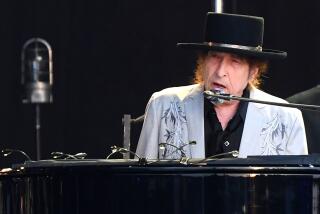THE MAGIC KINGDOM: Walt Disney and the American Way of Life.<i> By Steven Watts</i> .<i> Houghton Mifflin: 526 pp., $30</i>
If you were 10 years old in 1955, as I was, you might have put down a dime for a copy of MAD magazine and read with glee about “Mickey Rodent!,” Bill Elder and Harvey Kurtzman’s wicked cartoon satire of that iconic “beast turned man,” Mickey Mouse, as well as of that man turned pop-cultural beast, Walt Disney. Possibly that issue of MAD was even read by the young Richard Schickel, who in 1968 would write “The Disney Version,” the first critical biography of the Mouse’s owner and of the American way of Disney.
Giving Mickey an ominous 5 o’clock shadow, the MAD cartoonists exposed a mean streak in the Magic Kingdom. Mocking the way Walt Dizzy, as they called him, branded every aspect of his cartoon empire with his own name, they also mimicked to perfection his visual style, right down to the “furshlugginer three fingered” white gloves that seemed de rigueur in the Disney universe. Turning Mickey Mouse into a slavering human and reducing Donald Duck to, well, a duck, they offered a critical deconstruction of the Disney imperial style for his major audience of the time, us kids.
In “The Magic Kingdom,” a massive grab bag of a book referred to by its author as “a hybrid genre, part biography and part cultural analysis,” Steven Watts is not interested in the visual details of Disney cartoons or in Disney’s effect on or his place in the child’s universe. You won’t find an assessment, for instance, of how Disney, in the late 1930s, almost single-handedly enabled the business of childhood to break out of the Christmas season by linking it to the release of his full-length animated cartoons. And this may be all to the good: What Watts, a history professor at the University of Missouri, does best is to remind us that the Disney we ended up with, whether the “avuncular Uncle Walt,” patron saint of childhood and family values, or the right-wing entrepreneur and vulgar manipulator of pop culture, was not the Disney we began with.
Admittedly, even in the 1930s, enough children wore Mickey Mouse watches and played with Mickey Mouse toy trains to save both the Ingersoll-Waterbury Co. and the Lionel Corp. from bankruptcy, but at that time, the Disney phenomenon was hardly relegated to the realms of childhood. In 1933, for instance, in the bleakest days of the Great Depression, his brash young animation studio, which had only recently combined sound, music and luminous color into a new style of animation, released “The Three Little Pigs,” an eight-minute Silly Symphony cartoon. As Watts reminds us, the whole nation was soon singing and dancing to its catchy theme song, “Who’s Afraid of the Big, Bad Wolf?” Adult audiences stood to cheer when the cute pink pigs triumphed over the nasty wolf and (though Walt, in the “Aw, shucks” folksy style he was to patent, denied that the film held any timely meaning) interpretation soon followed: “[F]ilm critics, editorialists, [and] contributors of letters to the editor viewed the film as a Populist parable, a blow against the Great Depression on behalf of long-suffering common citizens. . . . Much like FDR’s inaugural speech a few months before . . . [it] struck many as saying ‘all you have to fear is fear itself.’ ” Viewers sensed that Disney’s cartoons were addressing their deepest fears, offering not just fun and escape but also New Deal-style hope and solidarity; simultaneously, they sensed that Disney was forging at his “fun factory” an experimental yet popular cultural form, a mixture of the industrial and the imaginative never before seen.
For the rest of the decade, while audiences mobbed movie theaters with each new Disney release, intellectuals of every heady stripe hailed him and rushed to associate themselves with his work. (Watts has done a marvelous job of unearthing and organizing this material.) He would be called “the modern Aesop,” “Leonardo da Disney,” “a 20th century Michelangelo” and “Saint Francis of the Silver Screen.” The Soviet filmmaker Sergei Eisenstein would describe his cartoons as “a revolt against . . . spiritual stagnation and grayness,” while the well-known American critic Gilbert Seldes would swear that his work offered “proof that the movies, as an art, are pure gold.” Meaning of every advanced and progressive sort would be discovered in his cartoons. The Communist paper the People’s World would even compare the dwarfs in “Snow White” to “a miniature communist society” (and the vultures to “Trotskyites”), hailing the film as “Walt Disney’s contribution to Marxist theory.”
Watts, by his own admission a 1950s Disney child (“I was ritually mesmerized by ‘The Mickey Mouse Club’ ”), returns eagerly, even nostalgically, to this fascinating if somewhat forgotten moment before his birth (“the Disney golden age,” as he calls it) when what would soon be termed “high,” “middle” and “lowbrow” culture seemed to merge in the figure of Walt and when it was possible for a modernist critic to embrace an avatar of popular taste. This may be Watts’ lost world, a time before critical intellectuals came to disdain Disney and so, it seemed, to disdain and be disdained by the people who flocked to his entertainments.
As Watts writes, Walt Disney managed the sense of loss that Americans felt in a country undergoing massive social change. His brilliance lay in his ability to meld “daringly innovative elements” with deep nostalgia and sentiment for a rural country that no longer existed. He “smoothed the jagged transition from the values of the Victorian age to those of a fledgling consumer America.” Even in his out-sized “ordinariness,” Disney cut a distinctly Bunyan-esque figure on the American landscape. With colorful jars of candy around his studio office, a private soda fountain at home and a half-mile of miniaturized rail in his backyard for his one-eighth-scale steam-powered train; with his inability to give credit to others and his odd bursts of generosity; with his almost sexual passion for his work, his prudishness about sex and his fascination with defecation; with his hard, rootless childhood lived mainly in cities, which he mythologized into an even harder yet more stable youth in the countryside; with his breakdowns, his drinking, his secretiveness and a streak of sentimentality wide enough to drown in, he was, as Watts never ceases to repeat, a “complex” man.
At the heart of this book are important questions that are only half-articulated: How do you explain the popular touch of the rakish-looking young man who left Kansas City, Mo., for Hollywood in 1923 without a contact in the movie world but with an ego as big as the Ritz and insecurities to match? How did he maintain his lock on mainstream tastes during four decades (with a few years off in the 1940s) of dizzying transformation? After all, his early anarchic cartoon shorts swept America in the late 1920s; his full-length animated cartoons took the country by storm in the late 1930s; his fantasy environment, Disneyland, became America’s home away from home in the mid-1950s; and by the time of his death in 1966, he had branded our future in the distinctly Disney-esque shape of the transnational entertainment universe we all live with today.
This is indeed remarkable, and Watts does an effective job of laying it out for us. But his project involves another kind of reclamation work as well. He has a touching urge to reclaim Disney and his “mainstream values.” To explain Walt’s unending popular touch, he tries to re-mythologize the most mythologized (and perhaps self-mythologizing) man of our times as a secret Populist. He proposes that Disney moved through stages of Populism with several increasingly “preservationist” phases, ending in the 1960s in what he calls “technocratic populism,” a kindly term for what he labels, slightly apologetically, “social engineering.” The effect of all this can be strained, even tautological, as Populism comes to mean little more than popularity. Despite presenting copious evidence to the contrary, Watts’ approach tends to downplay Disney’s truly innovative role in shaping and channeling mainstream values the way the Army Corps of Engineers once did rivers.
Certainly, “The Magic Kingdom” is a treasure trove of information on the Disney enterprise, but Watts stumbles badly on the central issue of how to embrace Disney’s popular touch without losing his critical sense. For this, Watts is not totally to blame. It has long been an American intellectual version of no-exit. To criticize popular culture is to reject America, but to embrace it is to reject the critical. Watts has not found his way out of this dilemma. Over and over, he ends up defensively assessing and softening the Disney record, whether on labor, Walt’s anti-communist career in Hollywood or his later artistic efforts. Sometimes, he must bend uncomfortably in his awkward embrace of Uncle Walt. In discussing charges of racism in the 1947 cartoon “Song of the South” and in other works, for instance, he notes studio memos filled with references to “darkies,” “pickaninnies” and “lazy niggers” but concludes that Walt himself was “a typical white American of his time who harbored a benign, genteel bias against blacks.” Typical, certainly, but “benign” is hardly a reasonable word for it.
If this book is an embrace, what a messy smooch it turns out to be. Too stuffed for a cultural essay, it is oddly organized to be a biography. Disney’s wife, Lillian, who married him in 1925, is not even introduced until Page 351, in the midst of a discussion of the 1950s, and Walt’s crucial relationship with his brother Roy, his studio alter ego, is not explored until the book’s final pages. Nonetheless, Watts must have something of those MAD cartoonists in him because, in a book otherwise strangely lacking in playfulness, he turns more playful and incisive in his writing only as the 1950s arrive. For genuine playfulness, though, you have to turn back to Schickel’s work, still fun to read after all these years.
“The Magic Kingdom” is an invaluable mine of material on how the American century became the Disney century, a world from Russia to Chile dominated by a Disney-esque culture overseen by the company Walt created. However, as we ready ourselves for our exit from Walt’s century into what looks increasingly like the century of Disney Inc., we still await the biographer who can lead us, critical faculties intact, to an exit sign. Perhaps, though, as in any dystopian story worth its salt, there will be no exit from this theater.
More to Read
Sign up for our Book Club newsletter
Get the latest news, events and more from the Los Angeles Times Book Club, and help us get L.A. reading and talking.
You may occasionally receive promotional content from the Los Angeles Times.






